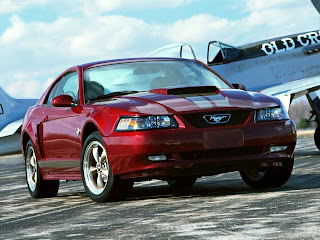The base model came with a 3.8 OHV V6 (232 cid) engine rated at 145 bhp (108 kW) in 1994 and 1995, or 150 bhp (110 kW) (1996–1998), and was mated to a standard 5-speed manual transmission or optional 4-speed automatic. Though initially used in the 1994 and 1995 Ford Mustang GT, Ford retired the 302 cid pushrod small-block V8 after nearly 40 years of use, replacing it with the newer Modular 4.6 L (281 cid) SOHC V8 in the 1996 Ford Mustang GT. The 4.6 L V8 was initially rated at 215 bhp (160 kW), 1996–1997, but was later increased to 225 bhp (168 kW) in 1998.
For 1999, the Ford Mustang received Ford's New Edge styling theme with sharper contours, larger wheel arches, and creases in its bodywork, but its basic proportions, interior design, and chassis remained the same as the previous model. The Ford Mustang's powertrains were carried over for 1999, but benefited from new improvements. The standard 3.8 L V6 had a new split-port induction system, and was rated at 190 bhp (140 kW) 1999–2004, while the Ford Mustang GT's 4.6 L V8 saw an increase in output to 260 bhp (190 kW) (1999–2004), due to a new head design and other enhancements. There were also three alternate models offered in this generation: the 2001 Bullitt, the 2003 and 2004 Mach 1, as well as the 320 bhp (240 kW) 1999 & 2001, and 390 bhp (290 kW) 2003–2004 Cobra.














-1.jpg)
2 comments:
First of all, unlike having to eat 6 times per day every
day your training should only be done 1 time per day 3 days per week
with at least one day of rest between training days.
There are many good muscle building and weight gaining programs
that you can buy and download from the internet. Make sure your kitchen is fully stocked with the
foods you need to eat.
Also visit my web site how to gain fat weight fast []
Pretty! This has been an extremely wonderful post.
Many thanks for providing this info.
Here is my page - memories :: ::
Post a Comment